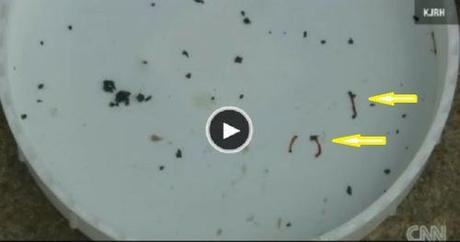My husband and I have a morbid joke about the United States becoming a Third World country. Alas, the joke is getting less and less funny, as it becomes more and more real.

First it was an Oklahoma town’s drinking water being infested with worms – icky blood worms, the larvae of small flies, up to half an inch long. (See photo above). Town officials have no idea how the worms got through the water filtering system.
Now we are told the tap water in New Orleans is infected with brain-eating bacteria.
Yikes!

Maggie Fox reports for NBC News, Sept. 16, 2013, that officials said a deadly brain amoeba that’s killed two boys this year has been found in a U.S. drinking water supply system for the first time — in a New Orleans-area system.
The Naegleria fowleri parasite killed a 4-year-old boy who likely got it playing on a back yard Slip ‘N Slide, Centers for Disease Control and Prevention officials say. Tests show the bacteria is present throughout the water supply system in St. Bernard Parish, directly southeast of New Orleans.
Dr. Michael Beach, head of water safety for the CDC, said: “We have never seen Naegleria colonizing a treated water supply before. From a U.S. perspective this is a unique situation.”
N. fowleri is a heat-loving amoeba that’s usually harmless, unless it gets up someone’s nose. It’s not entirely clear how or why, but in rare instances it can attach to one of the nerves that takes smell signals to the brain. There, the amoeba reproduces and the brain swelling and infection that follows is almost always deadly.
It killed a Miami-area boy last month — 12-year-old Zachary Reyna — and a 12-year-old Arkansas girl, Kali Hardig, is recovering slowly after an unusual experimental treatment.
N. fowleri is usually found in warm, fresh waters all over the world. It’s been seen in hot springs and swimming holes, freshwater lakes and even in neti pots used to clean out sinuses. Incomplete disinfection probably allowed it to thrive in St. Bernard, which has its own independent water system.
“The key to this is understanding that this amoeba is kind of a heat-loving bug,” Beach said in a telephone interview. “If water temperatures start going up, you really need to be extremely careful about maintaining the disinfectant. The farther you go from a plant, the more likely you are for the disinfectant levels to get low.”
N. fowleri has only been reported in about 130 people in the U.S. since 1962, making it extremely rare. Kali Hardig is only the third person known to have survived infection. It was formally identified in 1965, in Australia, where it did contaminate drinking water systems for a while, says Beach.
“In Australia, it was basically water being pumped from rivers and overland,” he says. The water got warm over long distances across the desert, and the amoeba thrived. Three children died after being immersed in baths and wading pools. Better disinfection has meant no cases since 1981, Australian health officials say.
Lousiana health department spokesman Ken Pastorick says officials are flushing out and decontaminating the St. Bernard Parish system, a process that may take several weeks: “They have shocked the water, so to speak. What has caused the problem here is low chlorination.” Pastorick says other Louisiana water systems are safe.
Beach says proper chlorination should take care of the amoeba contamination. He stresses that water is safe to drink and bathe in even if it’s contaminated. Stomach acid appears to kill the amoeba, and people can protect themselves by not snorting water up their noses, or not allowing it to be forced up the nose.
St. Bernard water customers are being cautioned not to fill kiddie pools with tap water, or to use other water toys such as the sliding game that the 4-year-old boy who died was playing on. Topping up swimming pools with hoses is a bad, idea, too, unless the water first goes through the disinfection system.
Louisiana state epidemiologist Dr. Raoult Ratard says the devastation wrought by Hurricane Katrina in August 2005 may ultimately be to blame. Low-lying St. Bernard Parish, badly hit by the flooding that Katrina caused, was almost completely depopulated. Ratard explains, “You have a lot of vacant lots and a lot of parts of the system where water is sitting there under the sun and not circulating.” That provided a perfect opportunity for the amoeba to multiply. Without enough chlorine to kill them, they can spread.
~Eowyn

